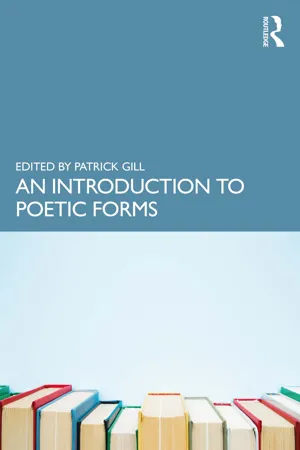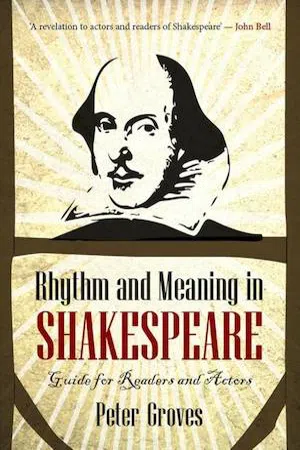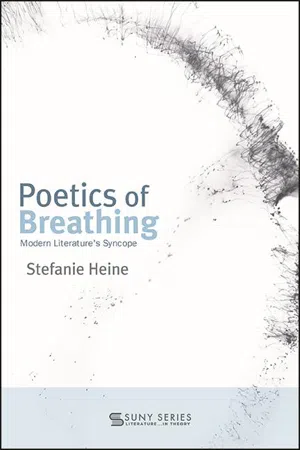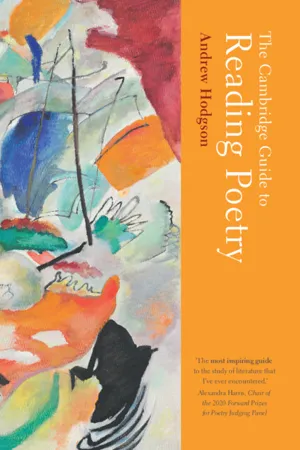Literature
Caesura
A caesura is a pause or break in a line of poetry, often marked by punctuation or a natural rhythm, which creates a sense of rhythm and emphasis. It can occur at a regular or irregular interval within a line and is used to add dramatic or emotional impact to the verse. In literature, caesuras help to control the pacing and flow of the poem.
Written by Perlego with AI-assistance
7 Key excerpts on "Caesura"
- eBook - ePub
- Patrick Gill(Author)
- 2022(Publication Date)
- Routledge(Publisher)
‘Caesura’ is thus a ‘cut’ in the ‘body’ of the line, linked to the implication of the production of ‘new life’ after the cut. More often than not, such a ‘cut’ operates as a pause; in the work of a dexterous poet working with a long line, there may be more than one such pause, and there may also be some ‘false’ and ‘true’ pauses. Note again the central (complete) line quoted above from Milton. Here there is a short pause (or false Caesura) after the first foot (‘The vales’), and again after the next foot (‘redoubled’). This is typical, as Caesura often acts in concert with the extension of rhythm and grammar. The strongest break in this line is where the comma is marked, which is a late position for a Caesura, but this late positioning and previous hesitation underlines the meaning of the line, which is to produce (as we have noted above in relation to the effect of the enjambment of the same line) an expansive sense of a long drawn-out movement from physical to metaphysical realms. The ‘fatal’ cut in the poem occurs after ‘Heaven’ is reached; there is nowhere further (in this poetic universe) for the bodies to go. Here Caesura serves an existential, even metaphysical, function. In a similar way, in Shakespeare’s King Lear’s final soliloquy (1606), the Caesuras mark repetition, change, and ultimately death, pointing finally towards an extralinguistic absolute: “Do you see this? Look on her! look! her lips! / Look there, look there! [ He dies ]” (A.V Sc.3 ll. 3500–3501). Whereas in Milton’s line there is a hesitation with the soft pauses, and something definite about the ‘true’ Caesura, here are too many possible true Caesuras; in a sense this is a clear example of the effects of over-breaking a line: after the first foot, the second, the third, until the end. The lines are riddled with as much articulate, exclamatory, space as language - eBook - ePub
- B. L. Gildersleeve, G. Lodge(Authors)
- 2013(Publication Date)
- Dover Publications(Publisher)
† .This incision serves as a pause, partly to rest the voice for a more vigorous effort, partly to prevent monotony by distributing the masses of the verse.REMARKS .— I . So in the Heroic Hexameter the great Caesura falls before the middle of the verse, to give the voice strength for the first Arsis of the second half.Ū na salū s victī s † nū llam spē rā re salū tem.— VERG.It does not occur at the middle, as in that case the verse would become monotonous.2 . In many treatises any incision in a verse is called a Caesura.751. Varieties of Caesura. — Caesurae have different names to show their position in the foot, as follows :Sē miternā ria, after the third half foot, i.e., in the second foot.Sē miquī nā ria, after the fifth half foot, i.e., in the third foot.Sē miseptē nā ria, after the seventh half foot, i.e., in the fourth foot.Sē minovē nā ria, after the ninth half foot, i.e., in the fifth foot.REMARK. — These Caesurae are frequently called after their Greek names, thus : trihemimeral, penthemimeral, hepthemimeral, etc.752. Masculine and Feminine Caesurae.— In trisyllabic metres, when the end of the word within the verse-foot falls on a Thesis, it is called a Masculine Caesura ; when on an Arsis, a Feminine Caesura.a, b, c, are Masculine Caesurae ; d, a Feminine Caesura.Especially noteworthy is the Feminine Caesura of the third foot in the Hexameter, called the Third Trochee (783, R. 2).753. Diaeresis.— When verse-foot and word-foot coincide, Diaeresis arises, marked ||Ī te domum saturae † venit || Hesperus || Ī te capellae.— VERG.REMARKs. — I - eBook - ePub
Music as Philosophy
Adorno and Beethoven's Late Style
- Michael Spitzer(Author)
- 2024(Publication Date)
- Indiana University Press(Publisher)
Anmerkungen zum Ödipus, an interpretation which moves well beyond Caesura’s conventional poetic function as a break between words in a metrical foot, or a pause near the middle of a line. The passage reads:For the tragic transport is actually empty, and the least restrained.—Thereby, in the rhythmic sequence of the representations wherein the transport presents itself, there becomes necessary what in poetic meter is called Caesura, the pure word, the counterrhythmic rupture—namely, in order to meet the onrushing change of representations at its highest point, in such a manner that not the change of representation but the representation itself very soon appears. (in Benjamin 2002, vol. 1: 340–41)Benjamin provides the most famous reading of this passage, embedded in his great essay on Goethe’s Elective Affinities (2002: 297–362). For Benjamin, Hölderlin’s Caesura is the expressionless (das Ausdrucklose) moment of sublime violence which interrupts a tragedy, as in Tiresias’s intervention in Sophocles’ Oedipus Rex. It is an expressly rhythmic device (Hölderlin’s “counter-rhythmic rupture”), albeit at several orders of abstraction: thinking of drama as a kind of “rhythm,” and of the interruption of a rhythmic sequence (the “onrushing change of representations”) as itself “rhythmic.” Adorno, confusingly, translates Hölderlin’s Caesura to Beethoven in two opposite senses. On the one hand, he identifies the Caesura as a particular moment in Beethoven’s sonata forms, located in the turning point between what he calls the “descending” and “ascending” curves of his two-part model of the development section, according to Hölderlin’s “calculable law of tragedy” (64). This is “the moment where subjectivity intervenes in the formal structure” (64), and it is epitomized, as we have seen in chapters 3 and 7 , by the new E-minor theme in the Eroica. In this regard, Adorno keeps faith with Hölderlin’s prescription of a single Caesura within a dramatic work (the E-minor theme, then, is Beethoven’s “Tiresias moment”). On the other hand, Caesuras in the early Spätstil essay are multiple and pervasive, a network of cracks and fissures across the entire late landscape. Between them, Adorno’s unitary and generalized models suggest that musical Caesura is actually a spectrum of devices, ranging from the local level to the architectonic. This is entirely in the spirit of the recursive, periodic nature of Classical phrase structure, by which language-like articulation (“punctuation”) operates at all levels of the piece. Caesura happens to be the normative category of late-eighteenth-century compositional theory, in its German form Einschnitt. Koch’s notion of Einschnitt derives from the verb schneiden, to cut, just as Caesura comes from the Latin caedere. In Koch’s Versuch, Einschnitte are the quasi-linguistic punctuation marks which articulate, or cut into, Classical discourse, with phrase endings and cadences.1 On the lowest level, punctuation is intrinsic to the stream of metrical pulses, the Schlagreihe, which constitutes the metaphorical model for Classical syntax in the writings of Sulzer and Koch. On the highest level, the articulation of a sonata-form movement into thematic groups and sections is a metaphorical mapping from this Schlagreihe. - Peter Groves(Author)
- 2013(Publication Date)
- Monash University Publishing(Publisher)
Cicele Berry refers to the normal Caesura as “a poise on a word – ie the word holds and lifts for a fraction of a second before it plunges into the second half of the line” (1993, 58). Te Caesura is not a feature of the metre: there may be none, or one, or many in any given line, and they may, but need not, be marked by punctuation: (126) ► 57 Titania: this wood| † thou wilt| or no|. ( MND 3.1.152-3) Te Caesura in the frst line of Titania’s splendidly imperious command is a cut produced by the moving (or ‘fronting’) of the adverbial phrase “out of this wood” from its default position at the end of the clause (phrases that are moved in this way carry their terminal boundaries with them): compare the fatter but more natural version “Do not desire to go out of this wood”, in which the Caesura has disappeared (the earliest texts place a helpful but ungrammatical comma at the Caesura: “Out of this wood, do not desire to goe”). We should distinguish two kinds of Caesura in English: the ordinary connective Caesura or joint (||), and the interruptive Caesura or fracture () that temporarily suspends the forward pressure of sense and grammar, generally coinciding with the ends of questions and exclamations and the edges of parentheticals (roughly, bits that could go in brackets or between dashes). Note that when such fractured junctures occur at line-ends they have the opposite efect, reinforcing metre rather than disrupting it. Te following two passages, separated by only sixty lines, show two very diferent Angelos – the frst, with just one fracture, calmly and confdently expounding the law; the second, with a dozen of them, agitatedly examining his dissolving sense of selfhood: (127) ► 58 Angelo: Te law hath not been dead, || though it hath slept. Tose many had not dar’d to do that evil 3. Pauses, Breaks and Transitions | 71 ^ If the frst that did th e edíct infringe Had answer’d for his deed.- eBook - ePub
Poetics of Breathing
Modern Literature's Syncope
- Stefanie Heine(Author)
- 2021(Publication Date)
- SUNY Press(Publisher)
In commenting on the phenomenon of Caesura in poetry, Agamben notes: “For the poet, the element that arrests the metrical impetus of the voice, the Caesura of verse, is thought” (The Idea of Prose 43). The thought mentioned here is—like Quintilian’s animus —hollowed of any content and located on the generative level: “The rhythmic transport that gives the verse its impetus is empty, is only the transport of itself. And it is the emptiness which, as pure word, the Caesura—for a little—thinks, holds in suspense, while for an instant the horse of poetry is stopped” (44). In Musil’s and Woolf’s texts, breath coincides with narrative Caesurae in which a “rhythmic transport” indeed creates the texts’ “impetus.” The parade of blossoms in Musil’s “Breaths of a Summer’s Day” marks a pause between Agathe’s and Ulrich’s exchange of thoughts. It is mentioned that the siblings’ conversation “issued from a dream of nature: the sight of the parade of blossoms” (1332; emphasis added). Thus, a Caesura—the eponymous breaths of a summer’s day—figures de facto at the center of the conversation: the breath-carried blossoms allowed it to emerge (“das Gespräch, hervorgegangen aus”; 1237; emphasis added) and keep determining its trajectory. What is addressed on the diegetic level coincides with the composition of the chapter on the formative level: already in a note to the chapter from 1938, Musil mentions that “the whole [chapter] is a continuation of the breaths = movement of the beginning and in accord/in unity with it” 11 (V, 3, 110; my translation) - ( An Essay on Man ) Here there is uniform end-stopping in each line. Furthermore, at the end of the second line of each couplet both syntax and sense reach an even clearer end-stopped pause than at the end of the first line. The couplets are thus said to be ‘closed’; indeed, each couplet would also still retain sense and vigour after being abstracted and quoted separately. Pope’s couplets use ‘separation’, that is, they resemble self-contained units; this gives the verse an epigrammatic force entirely appropriate to the sententious subject-matter of his poem. The above notwithstanding, end-stopped lines do not provide the only pauses in a line of verse. Another key metrical device is the break within a line, or ‘Caesura’, which the Oxford English Dictionary defines thus: ‘In English prosody: A pause or breathing-place about the middle of a metrical line, generally indicated by a pause in the sense’. In graphic scansion, the Caesura is marked thus: ||. In the Popean couplet, the Caesura is often found at the end of the second foot. These are the concluding lines of Pope’s Messiah : The seas shall waste, the skies in smoke decay, Rocks fall to dust, and mountains melt away; But fix’d his word, his saving power remains; – Thy realm for ever lasts, thy own Messiah reigns. The verse here is uniformly end-stopped, but also contains Caesuras in each line. In the first three heroic lines, they are in the standard position at the end of the Metre and rhythm 83 second foot. However, in the concluding line, Pope has substituted a twelve-syllable, six-beat alexandrine line for the usual pentameter and thus places the break later in the (longer) line. You will also have noted the trochaic substitution at the start of the second line; Pope, who was not infrequently attacked by Romantic period poets as a monotonous versifier, is actually a highly resourceful user of modulation.
- eBook - PDF
- Andrew Hodgson(Author)
- 2021(Publication Date)
- Cambridge University Press(Publisher)
I am and am not, I freeze and yet am burned, Since from myself another self I turned. The Queen’s emotions may be muddled, but the verse gets feeling into line. Each line holds contradictory emotions alongside one another – grief and composure, love and hate, silence and inward torment – before the passage reaches a climax as two pairs of conflicting impulses are crowded together in its penultimate line: being and not being, freezing and burning. The verse, then, clarifies feeling: whether this constitutes a triumph over the Queen’s turmoils or brings them into more intense focus is left open to question. It is a question which we can feel the poet revolving within each individual line. Speak the lines aloud and we find ourselves pausing at the end of each one – a tendency encouraged by the punctuation. But we will also find ourselves pausing for a breath – perhaps a slightly lighter one – in the middle of each line, in response to its movement back and forth between conflicting feelings: ‘I love [pause] and yet am forced to seem to hate’, ‘I do, [pause] yet dare not say I ever meant’, and so on. These pauses are known as Caesuras and are another way in which division into lines gives shape and definition to a voice. As these examples show, Caesuras need not fall directly in the middle of a line and need not be marked by punctuation (though punctuation might encourage a heavier pause). Elizabeth sets up a pattern by repeatedly positioning a Caesura early, so that each line see-saws, only just getting started before pausing and pursu- ing a contrary path as the Queen’s consciousness swings between extremes: ‘I feel this – but I’m acting in a contrary way’. The first three lines we looked at by Barrett Browning show a slightly more even dispersal of pauses: Nay, if there’s room for poets [pause] in this world A little overgrown [pause] (I think there is), Their sole work is [pause] to represent the age . . . 64 Reading a Poem
Index pages curate the most relevant extracts from our library of academic textbooks. They’ve been created using an in-house natural language model (NLM), each adding context and meaning to key research topics.






